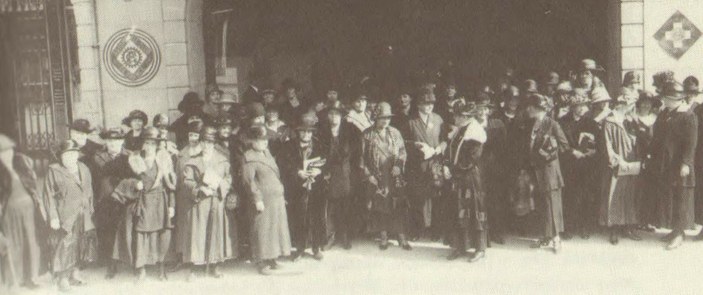After the introduction of the women's vote in 1971, the BSF's situation altered fundamentally. The Federal Committee for Women's Issues and the "new" women's movement in the 70s brought new political players of importance to the whole country to the fore and the BSF lost its dominant role representing women for Switzerland. The umbrella association attempted to adapt by means of another restructuring and a slight alteration of the name from "Frauenvereine" to "Frauenorganisationen". It is worth mentioning that among the changes to the content and structural form was mainly the acceptance of members from organisations which were not purely female, but which fought for women's issues. Creating departments in the working committee was hoped to unburden the president, and by setting an age limit for the staff of the offices and the representatives of the committees and the board, it was hoped to achieve a continuous regeneration of the umbrella organisation.
Thirty years later, the BSF, which had once had around 400,000 members, still represented about 100,000 women. Under the motto "The future of the BSF has already begun", a new reorganisation took place for the 100th anniversary celebration around the millennium. Now the board is made up of the hitherto existing bodies of the direction and the central board and the name BSF has been given up completely, becoming "alliance F".
Like many male organisations in the 20th century, the BSF was perceived mainly through its outstanding personages. The presidents Helene von Mülinen, Pauline Chaponnière-Chais, Clara Nef, Gertrud Haemmerli-Schindler, Huguette de Haller-Bernheim or the President of the International Women's Conference Jeanne Eder-Schwyzer are just some of the well-known and influential women recognised at home and abroad. "If one only paid attention to the media, one could imagine there might only be 20 or 30 competent women working for women's issues in Switzerland", it said in the annual BSF report in 1983. "And yet," added the author, "there are hundreds and thousands." One can only emphasise the fact by saying that there were, in fact, tens if not hundreds of thousands.
Union of Swiss Women's Societies
The first Swiss congress on women's issues took place during the national exhibition of 1896 in Geneva. At the final meeting, a committee of nine was agreed upon, which would in future be active in furthering women's issues. Three years later, the Women's Conference Berne, the Women's Union Geneva, the Women's Union Lausanne and the Union for Women's Efforts Zurich formed the Union of Swiss Women's Associations (Bund Schweizerischer Frauenvereine BSF). Following Helene von Mülinen's call for a constitutional founder's meeting on May 26th 1900 in Berne, 13 other women's organisations followed suit.
The BSF developed activities both nationally and internationally. It was not long before it presented a petition for the revision of the civil code. Working on entries and petitions concerning current legislation in social, legal, economic, political and societal questions became the BSF's main activity. In independent, permanent or temporary committees, but also in cooperation with representatives of organisations not associated with the BSF, committed BSF women developed and formulated numerous statements for the authorities, which usually appreciated the well-organised women's cooperation.
After the Swiss exhibition for women's work (SAFFA) in 1928 in Berne, the Central Office for Women's Professions took over part of the administrative work, leaving the rest to be carried out by the board members of the BSF themselves. Later, the Central Office for Women's Professions was incorporated into the Swiss Secretariat for Women's Issues in Zurich, founded in 1943 by the BSF and forty other associations. It was only in 1949, after a fundamental restructuring, that the umbrella organisation received staffed offices, after integration with the Swiss Secretariat for Women's Issues.
Apart from its own offices, the reorganisation led to more fundamental changes in membership structure in 1949. The 224 member organisations and individual members were then divided into two categories: group A consisted of those women's associations active all over Switzerland, as well as the cantonal women's centres and also those local associations which were not able to be coordinated into one of this category's associations. A-associations had a seat on the board but also in the working committee and a double vote in the assembly of delegates. Group B, on the other hand, was divided into local and regional women's organisations and private individuals who only had one vote at the assembly of delegates. With this categorisation, the women hoped to establish the BSF clearly as the head organisation over the others in order to represent women's issues to the administration more efficiently. In addition, this new structure was intended to simplify the flow of information between the BSF committees, the BSF representatives in the federal committees, the member organisations, the International Women's Conference and the authorities.




